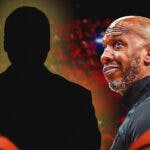Chauncey Billups was Neil Olshey's top choice as the Portland Trail Blazers' next head coach even before the job became available. Damian Lillard gave Billups his public seal of approval about 12 hours after Portland parted ways with Terry Stotts. Norman Powell says conversations with Billups played a major part in his decision to re-sign with the Blazers, and Jusuf Nurkic enters 2021-22 more optimistic than ever explicitly due to the confidence Portland's rookie coach has already instilled in him.
The Blazers, to a man, believe that not only is Billups an upgrade on the coach who'd previously roamed the sidelines in Rip City for every season of Lillard's nine-year career, making the playoffs eight consecutive times—the longest active streak in basketball. They seem fully convinced that Billups is the rare head coach capable of taking a talented, established team to new heights the vast majority of his peers couldn't, too.
Much of Billups' coaching appeal stems from his unique ability to relate to his players. Few in league history occupied as many roles—benchwarmer, draft bust, five-time All-Star and Finals MVP, to name a few—as Billups did during his 15-year playing career, perspective that affords him an immediate air of respect and legitimacy from the top of the roster to its fringes.
But Billups isn't all personality and intangibles. He took the Blazers job with a clear understanding of his team's strengths and weaknesses, with on-court plans to fortify the former and mitigate the latter.
Here are three statistics in which Portland is guaranteed to improve during Billups' debut season.
Percentage of Field Goals Assisted
The Blazers ranked last in assisted scores last season by a wide margin, getting help on just 51.5 percent of their made baskets, per NBA.com/stats, nearly three full points worse than the 29th-ranked New York Knicks. Drastic as that discrepancy is, it also hardly came as a surprise. The gulf between Portland and second-to-last in percentage of field goals assisted was even bigger two seasons ago, and the Blazers haven't ranked outside bottom-five in that category since 2016-17.
Personnel has a lot to do with that trend. Portland's roster tilted toward defense for much of Stotts' tenure once LaMarcus Aldridge left in the summer of 2015, leaving Lillard and C.J. McCollum to indulge their dribble-shoot tendencies basically at will. It's not like the Blazers came anywhere close to struggling on offense despite those ugly numbers; they've been no worse than third in offensive rating each of the last three seasons.
But Billups believes in a more egalitarian approach to offense than Stotts, one based on kinetic player and ball movement as opposed to rote ball screens and dribble hand-offs. He's spoken frequently about lessening the playmaking burdens on Lillard and McCollum in efforts to find them easier shots, too, as well as further unlocking Nurkic's underrated passing chops as a play initiator.
Portland would likely move up the rankings in assisted makes this season no matter who was calling the plays. Swapping rotation minutes of Carmelo Anthony and Enes Kanter for Larry Nance Jr. and Cody Zeller probably produces that effect all by itself. The implementation of Billups' modern offensive ethos looms largest for the Blazers on that side of the ball, though, and should have them receiving help on more scores than in any season since 2014-15, when Portland assisted on 56.7 percent of its baskets, 21st in the league.
Opponent Turnover Rate
Stotts deployed a notoriously conservative defensive scheme during his time with the Blazers, affording his defenders a short leash to deviate from the system to try and make disruptive plays. Portland tied for third-worst last season by forcing turnovers on 12.5 percent of opponents' possessions, another time-honored statistical standing at the bottom of the league. The Blazers ranked no better than 25th in opposing turnover rate during any season of Stotts' near decade-long stay in Rip City.
The defensive philosophy Billups plans to put into effect is far different, and not just because Portland hemorrhaged points a year ago. He's of the opinion that help principles go a long way toward fostering the trust needed to consistently manage stingy team defense.
“If you are going to help somebody, you have to have trust that somebody is going to help you,” Billups recently told Jason Quick of The Athletic. “That’s how our defense is going to be set up; it’s going to be a help defense. It’s not going to be one-on-one, Dame against Steph, they on an island and everybody sitting around watching. We are not going to play that type of defense. So now, we have to trust that, and that takes time. Especially coming from where they came from. Because from a numbers standpoint, there was not a lot of trust there defensively.”
This is another area where replacing Anthony and Kanter with Nance and Zeller alone would spark team-wide improvement. Nance, in particular, is a massive defensive upgrade, coming off a season in which he finished fourth in steals per game and sixth in deflections per game. Better health from Nurkic, who missed half the schedule last season, is a positive indicator here, too.
A higher opposing turnover rate may not be the crux of the Blazers' anticipated strides on defense during Billups' debut campaign. Either way, by virtue of both strategy and personnel, Portland's opponents are bound to suffer miscues more frequently.
Drives Per Game
Billups isn't Ty Lue, but it's worth remembering that the LA Clippers coach was his boss on the bench last season and remains one of his closest friends. Both say the month-and-a-half they spent ensconced at Billups' house during early parts of the COVID-19 pandemic served as a driving factor behind the latter's eventual coaching ethos.
Billups clearly values everything he learned last season as a Clippers assistant. He's regularly parroted LA talking points over the last three months while discussing his vision for the Blazers, homing in on the drive-kick-swing foundation that helped his former team thrash the Utah Jazz and advance to the Western Conference Finals despite missing Kawhi Leonard.
Penetration isn't solely for the sake of scoring at the rim. Billups fully understands the endless ripples of creasing the paint, as he explained during halftime of a Blazers Summer League game last month.
“Like we were on the worst teams in the league at creating corner three point shots,” he told ESPN's Mark Jones and Doris Burke. “I mean that's the best three-point shot in the game, and the only way to do that is to play with great pace, space and drive and kick and get paint touches. So that's gonna be something that's gonna be very important for how iIwant our team to play. That's the only way you break down defenses, is getting into the paint.”
Portland finished dead last with 30.7 drives per game last season, a long way from 29th. The addition of a north-south engine like Powell bumped that number a bit, but not enough to lift the Blazers from worst in the league.
Any less than 40 drives per game from Portland in 2021-22 would be disappointing. Billups' entire offensive belief system subsists on penetration, while Nance's addition and bigger roles for Anfernee Simons and Nassir Little were poised to juice the Blazers' off-dribble attacking in the first place.




